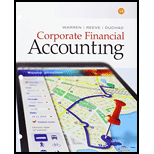
A.
Depreciation is an accounting method which is used to reduce the monetary value of fixed assets (except land), over a period of time due to use, wear and tear or obsolescence. It is also used to allocate the cost of asset over its life span.
Adjusting entries indicates those entries, which are passed in the books of accounts at the end of one accounting period. These entries are passed in the books of accounts as per the revenue recognition principle and the expenses recognition principle to adjust the revenue, and the expenses of a business in the period of their occurrence.
Rule of Debit and Credit:
Debit - Increase in all assets, expenses & dividends, and decrease in all liabilities and
Credit - Increase in all liabilities and stockholders’ equity, and decrease in all assets & expenses.
To prepare: The adjusting entry for depreciation expense.
B.
To identify: The items that would be erroneously stated on the income statement and on the
Want to see the full answer?
Check out a sample textbook solution
Chapter 3 Solutions
Bundle: Corporate Financial Accounting, Loose-leaf Version, 14th + CengageNOWv2, 1 term Printed Access Card
- I need guidance with this general accounting problem using the right accounting principles.arrow_forwardWhich principle requires expenses to be recorded in the same period as the revenues they help generate? A) Cost PrincipleB) Matching PrincipleC) Revenue Recognition PrincipleD) Full Disclosure Principlearrow_forwardNorthfield Appliances reported annual sales revenue of $2,750,000. During the year, accounts receivable increased from a $78,000 beginning balance to a $93,000 ending balance. Accounts payable increased from a $62,000 beginning balance to a $89,000 ending balance. How much is cash received from customers for the year? A. $3,130,000 B. $3,135,000 C. $2,735,000 D. $3,100,000 Right answerarrow_forward
- What is the effective cost of trade credit under the credit terms of 3/10, net 45? Assume 365 days in a year for your calculations. Round your answers to two decimal places. Do not round intermediate calculations.arrow_forwardI am looking for help with this financial accounting question using proper accounting standards.arrow_forwardI am looking for the correct answer to this general accounting question with appropriate explanations.arrow_forward
- Principles of Accounting Volume 1AccountingISBN:9781947172685Author:OpenStaxPublisher:OpenStax College
 College Accounting (Book Only): A Career ApproachAccountingISBN:9781337280570Author:Scott, Cathy J.Publisher:South-Western College Pub
College Accounting (Book Only): A Career ApproachAccountingISBN:9781337280570Author:Scott, Cathy J.Publisher:South-Western College Pub Financial AccountingAccountingISBN:9781337272124Author:Carl Warren, James M. Reeve, Jonathan DuchacPublisher:Cengage Learning
Financial AccountingAccountingISBN:9781337272124Author:Carl Warren, James M. Reeve, Jonathan DuchacPublisher:Cengage Learning  College Accounting, Chapters 1-27AccountingISBN:9781337794756Author:HEINTZ, James A.Publisher:Cengage Learning,
College Accounting, Chapters 1-27AccountingISBN:9781337794756Author:HEINTZ, James A.Publisher:Cengage Learning, Auditing: A Risk Based-Approach to Conducting a Q...AccountingISBN:9781305080577Author:Karla M Johnstone, Audrey A. Gramling, Larry E. RittenbergPublisher:South-Western College Pub
Auditing: A Risk Based-Approach to Conducting a Q...AccountingISBN:9781305080577Author:Karla M Johnstone, Audrey A. Gramling, Larry E. RittenbergPublisher:South-Western College Pub Intermediate Accounting: Reporting And AnalysisAccountingISBN:9781337788281Author:James M. Wahlen, Jefferson P. Jones, Donald PagachPublisher:Cengage Learning
Intermediate Accounting: Reporting And AnalysisAccountingISBN:9781337788281Author:James M. Wahlen, Jefferson P. Jones, Donald PagachPublisher:Cengage Learning





